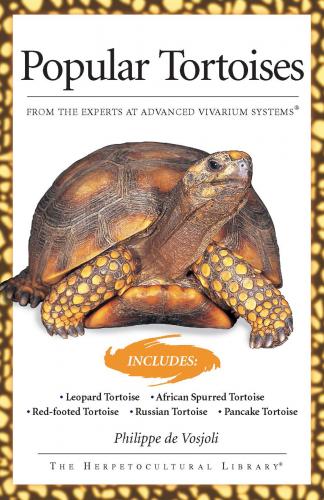The author would like to thank Chris Estep of Reptile Haven, Chuck Henderson of Rancho Tortuga, Mike and Margaret Hawley, Micki and Brad Dutenhoeffer, and Chris Wood for their help in providing photographs.
Vice President, Chief Content Officer: June Kikuchi
Vice President, Kennel Club Books: Andrew DePrisco
Production Supervisor: Jessica Jaensch
Assistant Production Manager: Tracy Vogtman
I-5 Press: Jennifer Calvert, Amy Deputato,
Lindsay Hanks, Karen Julian, Jarelle S. Stein
All photos by Philippe de Vosjoli, unless otherwise noted
Rachel Rice, indexer
Copyright © 1996 by Advanced Vivarium Systems, Inc.®
All rights reserved. No part of this publication may be reproduced or transmitted in any form or by any means, electronic or mechanical including photocopy, recording or any information and retrieval system, without permission in writing from the publisher, except by reviewer, who may quote brief passages in a review.
LCCN: 96-183295
ISBN-10: 1-882770-66-8
ISBN-13: 978-1-882770-66-3
eISBN-13: 978-1-620080-22-1
Cover photography by David Northcott
An Imprint of I-5 Press™
A Division of I-5 Publishing, LLC™
3 Burroughs
Irvine, CA 92618
www.facebook.com/i5press www.i5publishing.com
We want to hear from you. What books would you like to see in the future? Please feel free to write us with any comments on our AVS books.
Printed in China
13 12 11 6 7 8 9 10
The photographs in this book are courtesy of: Bill Love, pp. 7, 8, 41; Chris Estep, pp. 9, 13, 20, 21, 22, 24, 30, 31, 47; Chris Wood, pp. 10, 20, 26, 28; Jim Merli, pp. 14, 36; David Northcott, pp. 32, 50; John Tyson, pp. 34; Micki and Brad Dutenhoeffer, pp. 37, 47; Kevin Hanley, pp. 40; Jim Bridges, pp. 46, 55, 57;
CONTENTS
1: General Information: Before You Buy
2: Guidelines for Selecting Healthy Animals
5: Heating, Lighting, and Humidity
INTRODUCTION
Turtles have influenced human consciousness since the dawn of history. The creation myths of a number of early Asian, Indo-Pacific, and North American Indian cultures claimed that the Earth rested on the back of a giant turtle. In other cultures, numerous ancient fables, such as “The Tortoise and the Hare,” feature the slow-moving tortoise as a steady, dependable hero. Undoubtedly, early civilizations were drawn to the turtle’s unusual combination of hard and soft features, made possible by an internal skeleton that evolved into a hard, protective armor—the portable shelter that we call a shell.
Tortoises, a specialized group of primarily herbivorous (plant-eating) turtles adapted to living on land, still fascinate all those who set eyes on them. Their special adaptive features, including a rounded form and facial structure, stubby elephant-like legs, and a docile temperament, have invariably drawn the attention of many prospective pet owners. As pets, they can be very rewarding and long-lived, as long as you select the right species for your living conditions and pay attention to some basic requirements. Before purchasing a tortoise, remember, as a group, tortoises will ultimately require the space equivalent to at least a large portion of a room—one that is larger than the standard size reptile enclosures available in pet stores.
One of the main advantages and challenges of keeping tortoises is that they are primarily vegetarians. You can purchase food at the supermarket or a local feed store, or grow it in your garden. As with humans on a vegetarian diet, however, you must offer a balanced regimen that meets their requirements, particularly with regards to certain vitamins and minerals (notably calcium). Many prospective tortoise owners are also surprised that tortoises are actually reptiles, which means that they are endotherms or, in popular terms, that they are cold-blooded. Like other reptiles, they depend on an external heat source and the landscape of their environment to regulate their body temperature. In captivity, they require conditions that combine both a heated area and a cooler shaded area in order to select their preferred temperature. This book provides no-nonsense information on these concerns and other important requirements. It will help you select the right tortoise species for your conditions and show you how to give it a long and healthy life.
It would be irresponsible to talk about keeping tortoises without mentioning their conservation status. Many of the world’s turtle populations are on the path to extinction and may not survive the ravages of habitat destruction, collection for food and bogus medicinal use, ineffective wildlife legislation (both international and national), and, with some species, over-collection for the pet trade. Against this backdrop of global decline, with the exception of the commercially produced African spurred tortoise, the leopard tortoise, and possibly the red-footed tortoise, every species of tortoise available today is a representative of the last of their kind, a precious life to be respected. There are many reasons why tortoises are easily threatened by over-exploitation. Most tortoises require at least nine years to reach sexual maturity and some species produce only small numbers of hatchlings, all of which are subject to predation. The consequences of collecting or killing adults from shrinking natural habitats are obvious. Depending on the numbers of adults removed, it can take years for a breeding population to recover—assuming that there are enough tortoises left in the habitat.
Today, tortoise hobbyists are in a unique position. We are still fortunate enough to be able to purchase, own, and work with a variety of species, and we can help delay the decline of tortoise populations by developing self-sustaining tortoise populations in captivity. Further, we can actively contribute to the creation and implementation of sound wildlife legislation. We have a special position of responsibility. Tortoises are not living toys. They
